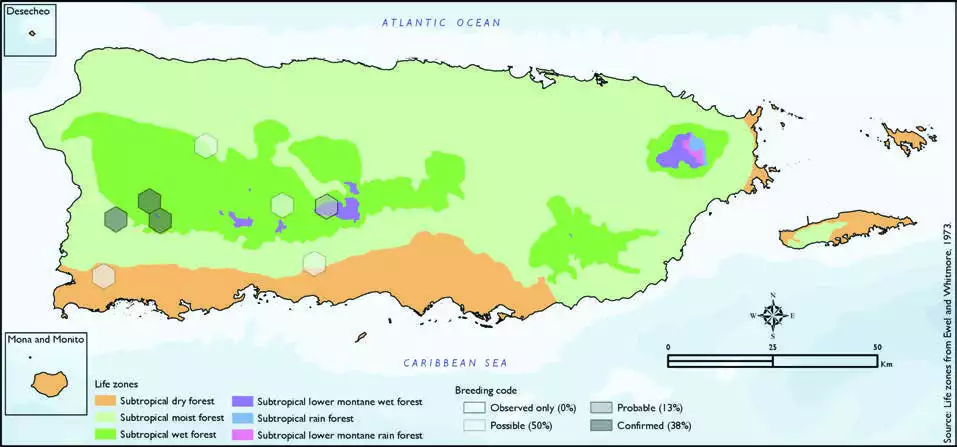Sharp-shinned Hawk
Description
The sharp-shinned hawk (Accipiter striatus) is a small hawk, with males being the smallest hawks in the United States and Canada, but with the species averaging larger than some Neotropical species, such as the tiny hawk. The taxonomy is far from resolved, with some authorities considering the southern taxa to represent three separate species: white-breasted hawk (A. chionogaster), plain-breasted hawk (A. ventralis), and rufous-thighed hawk (A. erythronemius). The American Ornithological Society keeps all four species conspecific.
This section needs additional citations for verification. Please help improve this article by adding citations to reliable sources. Unsourced material may be challenged and removed. (April 2016) (Learn how and when to remove this template message)
Distribution & Habitat
The Sharp-shinned Hawk occurs through North, Central,
and South America (Biaggi
1997, Raffaele and others 1998)
including the West Indies,
where it is a common year-
round resident on Cuba and Hispaniola, and rare on Puerto
Rico (Raffaele and others
1998). The Puerto Rican Sharp-
shinned Hawk (A. s. venator)
is an endangered breeding
resident subspecies found in
the montane forests and shade
coffee plantations of Puerto Rico
(Delannoy 1992). Historically,
the species bred in the Sierra
de Cayey, Sierra de Luquillo,
and the central west portion
of the Cordillera Central (e.g.,
Maricao forest) mostly above
400 m elevation (Delannoy
and Cruz 1999, Oberle 2018).
However, recent surveys indicate
that the species has declined
in population (especially in
Maricao) and distribution, and is now believed to be isolated in a
few montane forests (Delannoy
1992, Gallardo and Vilella
2014). A single individual was
observed on Mona in 1972 and
considered vagrant (Terborgh
and Faaborg 1973). The atlas
fieldwork yielded a total of 20
records within eight hexagons
or 2 percent of the 479 total
hexagons (see map). Of the eight
hexagons where this species was
found, breeding met the atlas
definition of confirmed in 38
percent (three) of the hexagons,
probable in 13 percent (one),
and possible in 50 percent (four)
(see map).Sharp-shinned Hawk distribution. The map shows the highest breeding code by hexagon and overlaying the ecological life zones in
Puerto Rico. Note: percentages may not total 100 due to rounding. 169Sharp-shinned Hawk/Halcón o Gavilán de Sierra

Breeding Habits
Previously published reports indicate that the Sharp-shinned
Hawk breeds from March to
June (Delannoy and Cruz 1988,
Raffaele and others 1998).
The nest is a platform made
of twigs built high in a tree or
palm (Delannoy and Cruz 1988,
Raffaele and others 1998). Atlas
results show that this species
breeds mostly from November
to June and also during August,
with the most breeding activity
during February to April (see
chart). Overall, the breeding
activity peaks in March and
mostly takes place within
subtropical wet forest life zones
(see chart). Results show that
this species breeds mostly within subtropical wet and lower
montane wet forest life zones (63
percent of the hexagons), but
it also breeds in the subtropical
moist forest life zone (25 percent
of the hexagons) and may also
breed within the subtropical dry
forest life zone (13 percent of the
hexagons) (see table and map).
Conservation
The current population trend of the Sharp-shinned Hawk is
described as increasing in North
America (Butcher and Niven
2007), and it is currently listed
as a species of least concern by
the IUCN (BirdLife International
2016). Nonetheless, the Puerto
Rican subspecies (A. s. venator)
is critically endangered (PRDNER 2016) and is included on the
Federal Endangered Species
List (USFWS 1973) as it has
declined dramatically in the
Sierra de Luquillo and Carite
forests, mostly due to hurricanes,
introduced predators, egg/
chick predation by the Pearly-
eyed Thrasher (Margarops
fuscatus), and nest failures due
to fl edglings infested with botfl y
larvae (Philornis spp.) (Delannoy
1992; Gallardo and Vilella 2014,
2017; Oberle 2018). In Puerto
Rico, the Sharp-shinned Hawk
has a protected habitat in land of
26 percent or 49 km2 of the total area covered by the hexagons
where evidence of breeding was
found for this species (191 km2).
Related Species
Family:
hawk